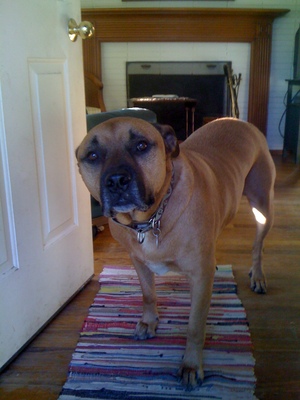Time to go out! Stopping dog excitement at the door

Teaching your dog to wait politely at the door not only makes life more pleasant but also keeps your furry friend safe.
Amy Samida | Contributor
Belinda wrote: “We have two dogs, an Airedale and a Corgi/pug. When it is time to go out, they barge through the door, falling over each other. Sometimes the Corgi/pug will jump up and bite the Airedale's cheek. He is very mild mannered and puts up with this. How do I stop the barging and the little one biting?”
First, give your Airedale a pat from me, and tell him that even though I haven't met him I think he is a VERY good boy for being so tolerant! Door barging, whether it's time to go for a walk or just out into the backyard, is really common. Especially when you're going out into the yard where you don't have that pesky leash holding you back and you can blast out, preferably barking like a mad dog, and race around the yard at top speed! Woohoo! It's great!
The most important thing to remember in this type of situation is that every time you open the door when the dogs are still in such an excited state, you're giving them the absolutely BEST reward for their behavior. Oops! Because in addition to be annoying to the humans and other dogs, having your four-footed friend dashing out of doors willy-nilly can be unsafe, given traffic and all those other unsafe, outside things. All dogs should know to wait until they're given the word before going out the door.
I actually find this a pretty easy problem to correct, one that doesn't take a lot of effort because the reward is right there, and every time it's offered, the dog(s) will want it. One way to correct the problem is to just walk to the door, saying whatever it is you usually say. In Belinda's case, and if you have a dog who starts grabbing at one of the other dogs, you can put the grabber on a leash. Put your hand on the doorknob, and just wait. Eventually they will settle down, confused as to why, oh why, you're not opening the door. You can use the leash to curtail the leaping up, face biting activity, again being quiet, just using the leash to prevent the behavior.
Tell them to “Wait”, then slowly start to open the door. When they inevitably start leaping around again, simply close the door. No attitude, no corrections, no anything. Don't use the leash to stop the dog from going outside; it's just to prevent the other dog from being used as a chew toy. You just quietly close the door. " Hm. What's going on?" runs through the little dog brains.
Once they've settled again, tell them “Wait” and slowly open the door, closing it quietly when the excitement builds. Eventually you'll be able to open the door wide with both dogs waiting. At this point, I generally let one dog out, saying “OK, Tug” then do the quick body block dance, closing the door until the second dog (and third dog, in my case) settles again, at which point I give the “wait” command again and do the door opening slowly routine until dog number two waits until I give her the okay.
I like to use this method because even though it may take twenty minutes to get one dog out the door the first go-round, they tend to improve at super speed, and it's very rewarding, to me as well as to them. Hey, I work hard to make sure my dogs have a really happy life. I deserve some reward for that effort. I don't want to do an involved training setup for something that's such a routine part of our day, but I do want a little restraint. The reason I let one dog out at a time is that it reduces the initial tear-around-the-yard excitement. Eventually, this behavior tends to diminish, and all the dogs can go out at once.
Whimsy and Tug have known this from their first days with me. When we added Rocket, it was like Whimsy and Tug developed a sudden amnesia, with jumping, and wrestling, and general out-of-control, time-to-go-out hoopla. So we went back to square one, doing the routine above, with Tug usually being the first to get to leave, since he's the oldest and the best, then Whimsy, finally, trundling along many minutes later, Rocket. The added benefit of letting one dog out at a time is that you can reward the dog who is getting himself under control the fastest and being the best behaved by giving them access to the yard first. Now that's a great reward!
Amy Samida is interested in furry, four-footed friends and the people who love them -- training, showing, grooming, and just plain hanging out with them. Her career has included dog training, professional grooming, veterinary nursing and now dog day care.

